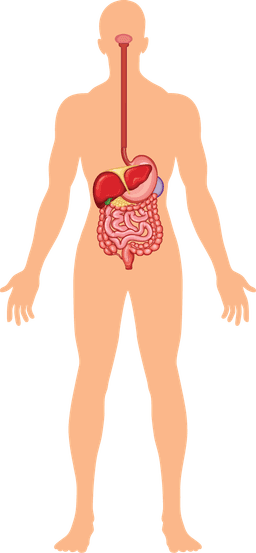Myths about teaching can hold you back
- Year 8
Digestion and enzymes
I can describe the processes of mechanical and chemical digestion that break down food to release nutrients, including the role of enzymes.
- Year 8
Digestion and enzymes
I can describe the processes of mechanical and chemical digestion that break down food to release nutrients, including the role of enzymes.
These resources will be removed by end of Summer Term 2025.
Switch to our new teaching resources now - designed by teachers and leading subject experts, and tested in classrooms.
These resources were created for remote use during the pandemic and are not designed for classroom teaching.
Lesson details
Key learning points
- The differences between mechanical and chemical digestion and where they take place.
- Food is made up of carbohydrates, proteins and fats.
- Carbohydrates, proteins and fats in food are broken down by digestion into smaller molecules that can be absorbed.
- Enzymes are biological molecules that act as catalysts to speed up chemical digestion of carbohydrate, protein and fat.
- Enzymes digest carbohydrates into starch and sugars, proteins into amino acids, and fats into fatty acids and glycerol.
Keywords
Digestion - Digestion is the process of breaking down large food molecules into smaller molecules that can be absorbed into the blood.
Enzyme - An enzyme is a biological molecule that is a catalyst that speeds up the rate of a reaction.
Carbohydrate - A carbohydrate is a molecule made of carbon, hydrogen and oxygen, and provides energy.
Protein - A protein is a molecule made of amino acids, and is used for growth and repair.
Fat - A fat is a molecule that is stored and used for energy.
Common misconception
Food is absorbed without being digested; or "goodness" from food is what is absorbed.
The lesson explores the roles of mechanical and chemical digestion (by enzymes) of different food types into small molecules to be absorbed.
To help you plan your year 8 science lesson on: Digestion and enzymes, download all teaching resources for free and adapt to suit your pupils' needs...
To help you plan your year 8 science lesson on: Digestion and enzymes, download all teaching resources for free and adapt to suit your pupils' needs.
The starter quiz will activate and check your pupils' prior knowledge, with versions available both with and without answers in PDF format.
We use learning cycles to break down learning into key concepts or ideas linked to the learning outcome. Each learning cycle features explanations with checks for understanding and practice tasks with feedback. All of this is found in our slide decks, ready for you to download and edit. The practice tasks are also available as printable worksheets and some lessons have additional materials with extra material you might need for teaching the lesson.
The assessment exit quiz will test your pupils' understanding of the key learning points.
Our video is a tool for planning, showing how other teachers might teach the lesson, offering helpful tips, modelled explanations and inspiration for your own delivery in the classroom. Plus, you can set it as homework or revision for pupils and keep their learning on track by sharing an online pupil version of this lesson.
Explore more key stage 3 science lessons from the Human digestive system unit, dive into the full secondary science curriculum, or learn more about lesson planning.

Licence
Prior knowledge starter quiz
6 Questions
Q1.What is digestion?
Q2.Match the nutrient to the food source.
potatoes
meat
butter
Q3.Which is the correct order that food passes through the digestive system?

Q4.All the organs involved in digestion make up the __________ which breaks down food and absorbs nutrients.
Q5.What is the role of the large intestine?
Q6.Match the digestive glands with their function.
Secrete digestive chemicals and add water
Secretes digestive chemicals
Secretes bile
Assessment exit quiz
6 Questions
Q1.Grinding food, rolling food around by the tongue and churning are all examples of which type of digestion?
Q2.True of false? Digestion can turn soluble food into insoluble food.
Q3.Which small unit are large carbohydrates like starch broken down into?
Q4.What are the enzymes that digest proteins called?
Q5.Who is right?





